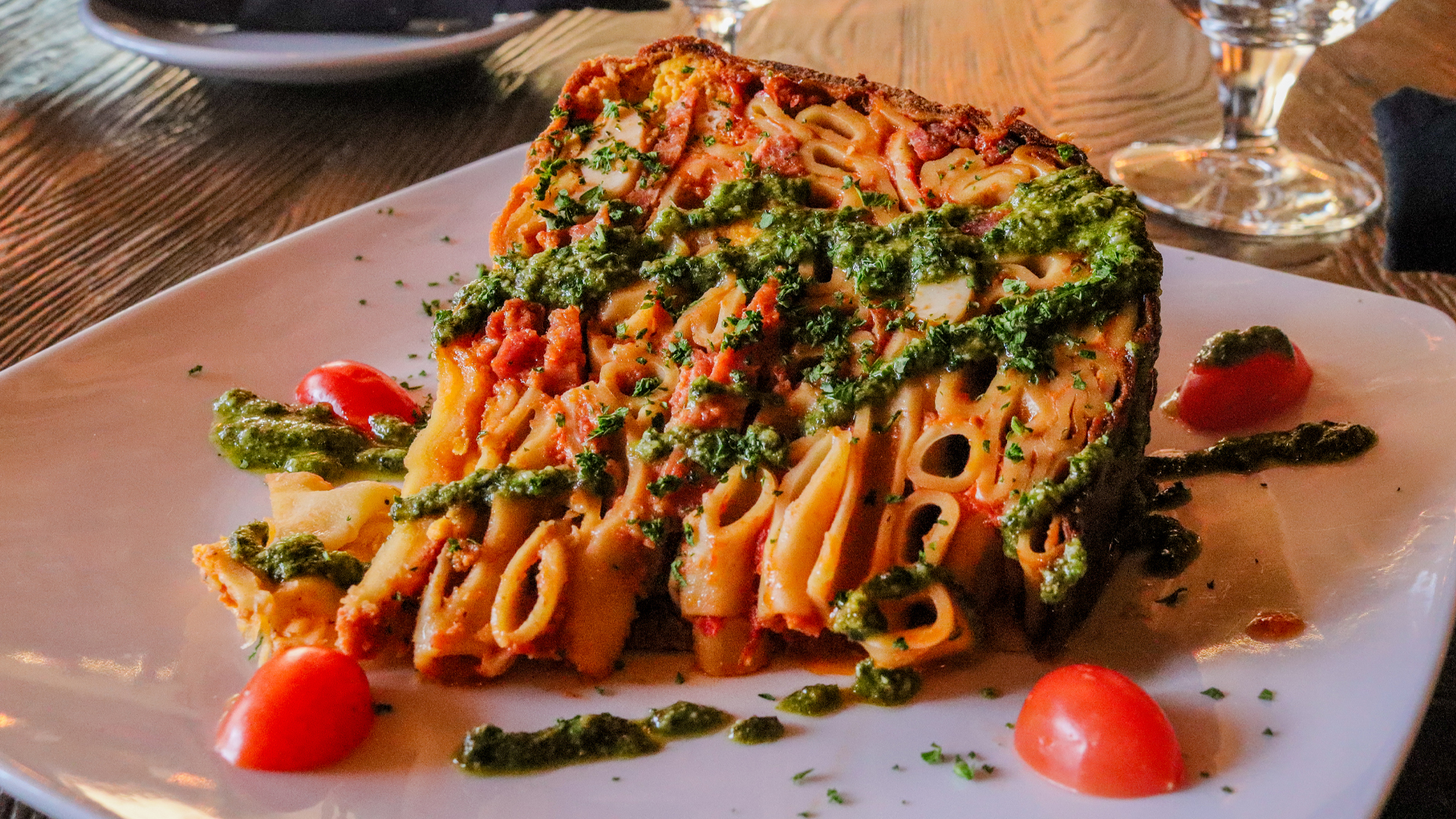The biggest star of the 1996 film Big Night isn't Stanley Tucci or Tony Shalhoub, but rather the timpano, the massive baked pasta dish the restaurant-owning brothers serve their guests on the night of the huge dinner. Timpano is a classic Italian dish dating back at least to the 19th Century.
In Tucci's Memoir, he explains how his family would make a timpano every year for Christmas dinner. While he was writing the film Big Night, he realized the script required an extravagant but exotic dish at the center of the plot. The lesser-known Italian specialty found its audience, and the cult classic film has turned timpano into an icon of excess.
What exactly is a timpano? It's a baked dish layered with meats, macaroni, sauce, and other delicacies wrapped up in pasta. The timpano in Big Night begins with a layer of ziti in tomato sauce, hard-boiled eggs, and sliced sausage with each layer repeated twice, all wrapped together and baked in a shell of fresh-made pasta.
The term timpano is commonly used around Naples, a dialect for the more common phrase timballo. Both words come from the French word timbale, a type of cylindrical pot used to cook a dish. The pans also look like kettledrums known as timpani, from which the French word for the baking pan is derived.
In France, the term timbale also refers to the foods cooked in a pan. However, there isn't anything descriptive indicating shape or size. French timbale can range in size from a large pot used to cook panettone or shallow like a tart pan.
An ideal timballo should have a height equal to its width. And the traditional pan shape is cylindrical with a slight taper near the bottom. However, other shapes like a rectangular pan or even a wreath-like circle may be used at the risk of angering timballo purists.
The origin of timballo likely originated in the 19th Century, just as spaghetti and tomato sauce were coming together for the first time. Pellegrino Artusi includes a timballo di piccioni in his seminal Science in the Kitchen and the Art of Eating Well. Here the title protein is piccioni, the pigeon, but the recipe also includes ham, chicken, giblets, bechamel sauce, and macaroni. He promised a dish made with just two pigeons will likely feed as many as ten to twelve people.
In 1958, the novelist Giuseppe Tommasi di Lampedusa describes a timballo in his posthumously published novel The Leopard. The novel won the Strega Prize in 1959, the highest prize for Italian novels, and tells the story of Don Fabrizio Corbera, a prince and nobleman in Sicily. His timpano includes chicken livers, boiled eggs, ham, and truffles.
Timballos can be stuffed with a wide variety of foods. The historian Anna Del Conte explains in The Concise Gastronomy of Italy that different versions will include starches like rice or gnocchi, stuffed pasta like ravioli, or shapes like taglioni and tagliatelle.
The types and variations of timballo vary by region but usually include some variation of cooked pasta in sauce and meats and vegetables. A generic term for these variations is known as timballo di maccheroni, a reference to the pasta used in the filling.
However, there are of course exceptions. From the Abruzzo region, timballo di scrippelle includes many layers of crepes stacked on top of each other. The fillings between each layer are thin. They can include meatballs, onions, and bechamel sauce, and usually are made either as a white version or red, with tomato sauce.
Not all timpano is wrapped in pasta. The Timaballo di sfoglie swaps out the pasta for puff pastry and macaroni in the filling is accompanied by vegetables like zucchini and artichokes. These pies with puff pastry are also known as Pasticcio di Maccheroni with versions like one made in Ferrara filled with macaroni cooked in a sauce of meat and truffles.

Timpano drizzled with a little pesto sauce from Misto Restaurant in the Bronx, NY (Photo credit: AJ Forrisi)
Eggplants can also be used to wrap up the filling, as is the case with timballo di melanzane. The pasta shell is replaced with strips of fried eggplant. The eggplant is cooked long enough to soften wide strips that line the pan and then wrapped around the filling before being baked in the oven.
Then of course there is the Pope's timballo. Timballo alla Bonifacio VII is named after the 13th Century Pope who is thought to have tricked his predecessor into resigning by pretending to be the voice of God. Boniface amplified his voice through a pipe connected to Pope Celestine V's bedroom. Boniface then spoke to the sitting Pope while he slept, convincing him to resign. Originating in Lazio, there are many variations on the filling of this timballo, but what differentiates it from the others is the pasta shell is replaced with ham slices.
There is also the crustless Timballo di Anelletti made by packing Anelli pasta directly into the pan. The pasta is combined with sauce and sometimes meat and cheese. This version originates in Palermo and often is cooked into a ring shape. The heat of the pan causes a crust to form where the pasta touches the pan.
And timpano also isn't unique to Italians. On the island of Malta, a nation between Sicily and Libya, locals make timpana, made with long tubular pasta and meat sauce and wrapped in pastry dough. Typically the dish is made with penne or ziti. Greeks serve pastitsio, a sheet of baked pasta inspired by pasticcio di maccheroni, and Egyptians serve a similar combination where it's called macaroni bechamel.
Timballo, timpano, and timpana are grand feasts, easily serving a dozen people. Mostly these are celebration dishes reserved for holidays like Christmas or Easter. Or in the case of the brothers Primo and Secondo, a spectacular dinner to impress their guests in one final Big Night.


